This post may contain affiliate links. Please read my disclosure and privacy policy.
These Gluten-Free Cinnamon Rolls are the best you’ll ever make. (Seriously!) They have a tender texture, just like the traditional version, only without the gluten.
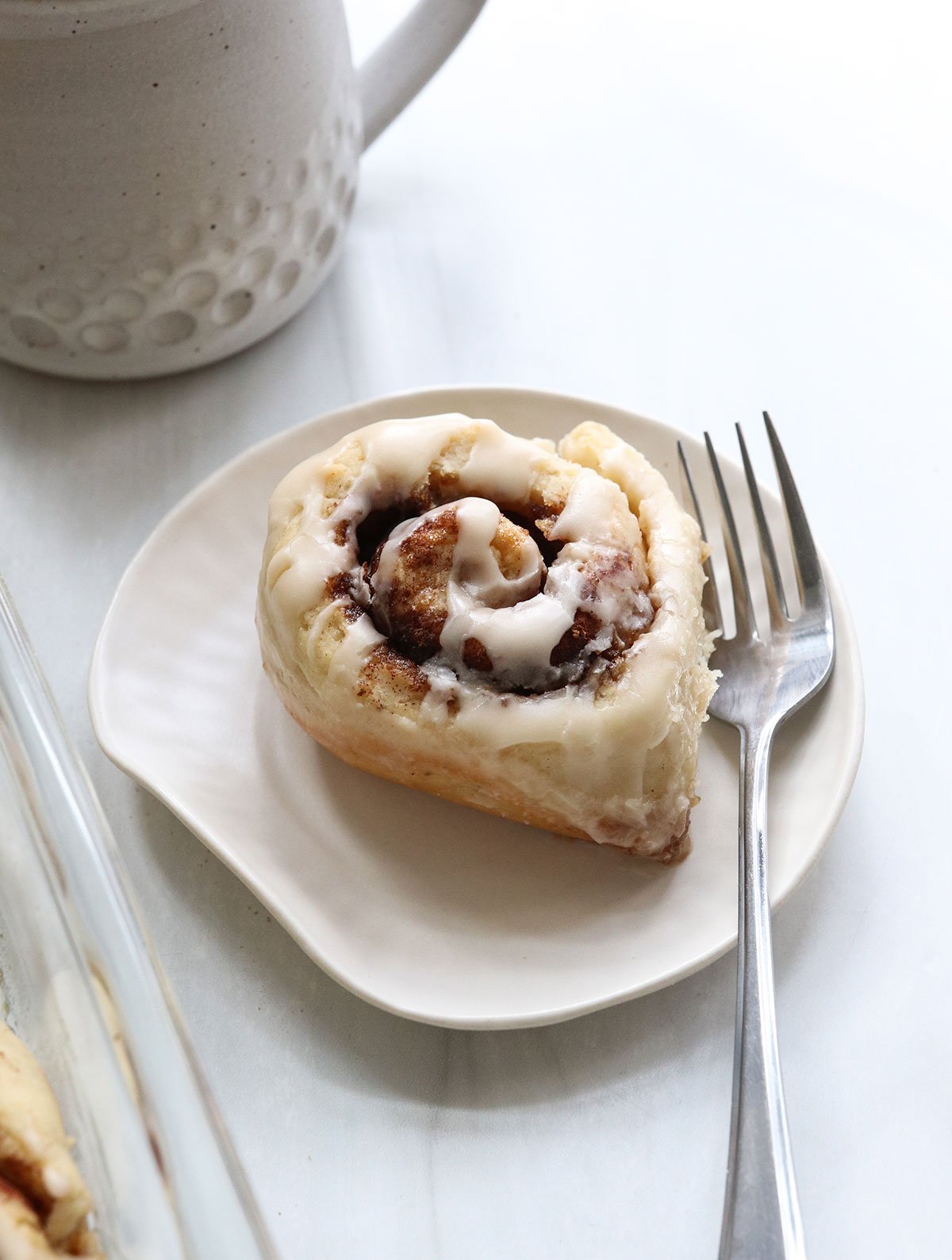
Why You’ll Love Them
They have an authentic texture. Gluten-free flour blends tend to create a cinnamon roll with the texture of a biscuit or scone because they lack the elasticity that gluten provides. However, you can fix this with a magic ingredient: psyllium husk! (More details below.)
They rise like traditional rolls. These gluten-free cinnamon rolls will grow in size and fill the pan, just like traditional recipes do. They also have extra soluble fiber in each bite, so that’s a bonus.
They taste amazing! Since cinnamon rolls tend to be a special holiday treat, I’m sharing all the tricks for making them taste better than the ones you’d buy from a bakery. This includes a caramelized base and a melt-in-your-mouth powdered sugar frosting, but I’ve also included options in the notes if you prefer to avoid using refined sugar. (We make them with brown sugar and melted butter for Christmas morning.)
They are tested and perfected. If you’ve been disappointed by other gluten-free cinnamon roll recipes, this is the recipe for you. I’ve tested over 30 batches of cinnamon rolls to make sure these are the BEST in both taste & texture. Just be sure to use the EXACT ingredients called for, and read the substitution notes if you need to make them dairy-free or vegan.
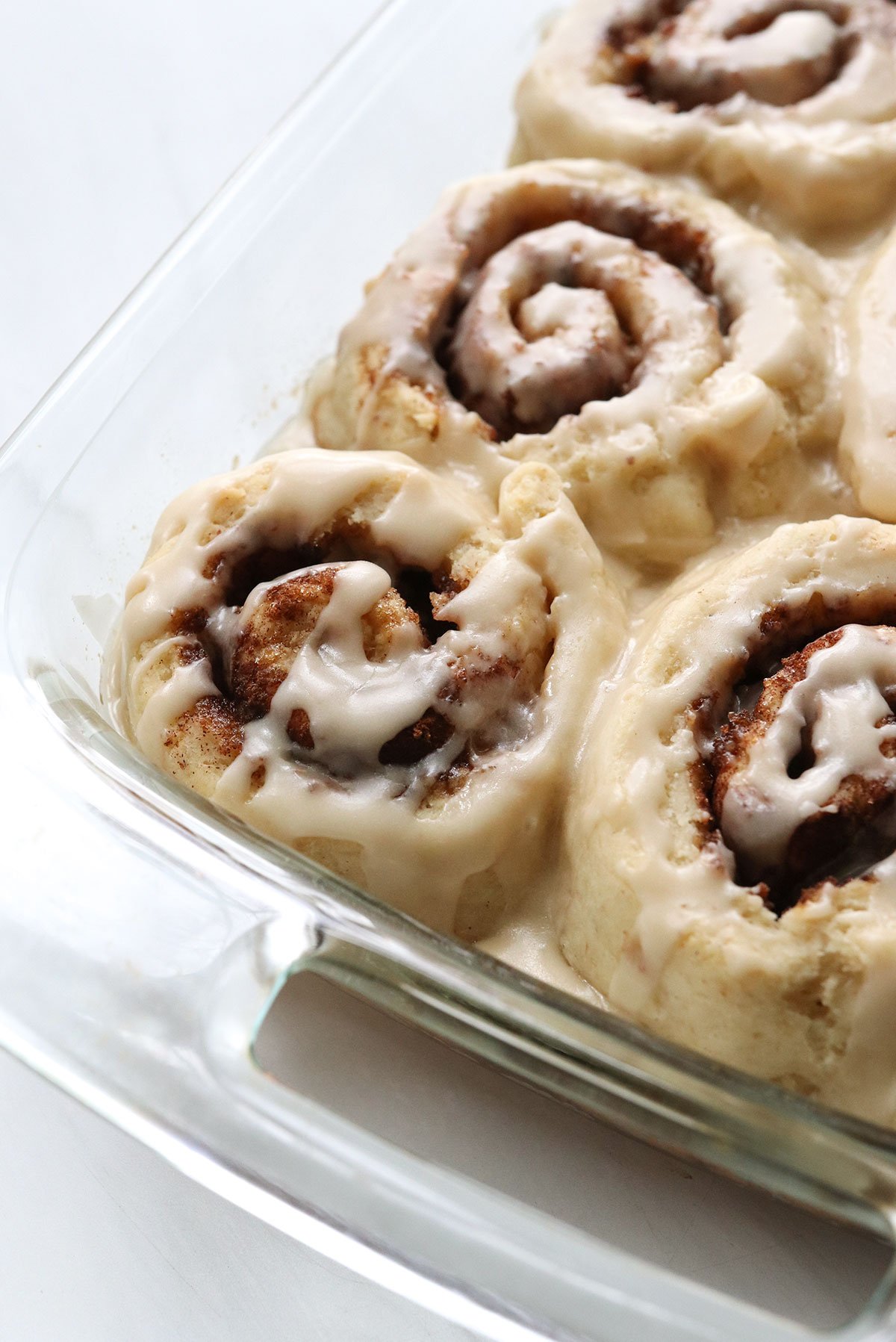
Ingredients You’ll Need
You’ll need to use a gluten-free flour blend that includes xanthan gum for this recipe to work, and I recommend using Bob’s Red Mill 1-to-1 Baking Flour (affiliate link) since that’s what I tested this recipe with.
Active dry yeast will help the cinnamon rolls rise, but if you need to use instant yeast instead, you can skip the “proofing” step at the beginning. Just add the warm water and yeast directly into the dough, in that case.
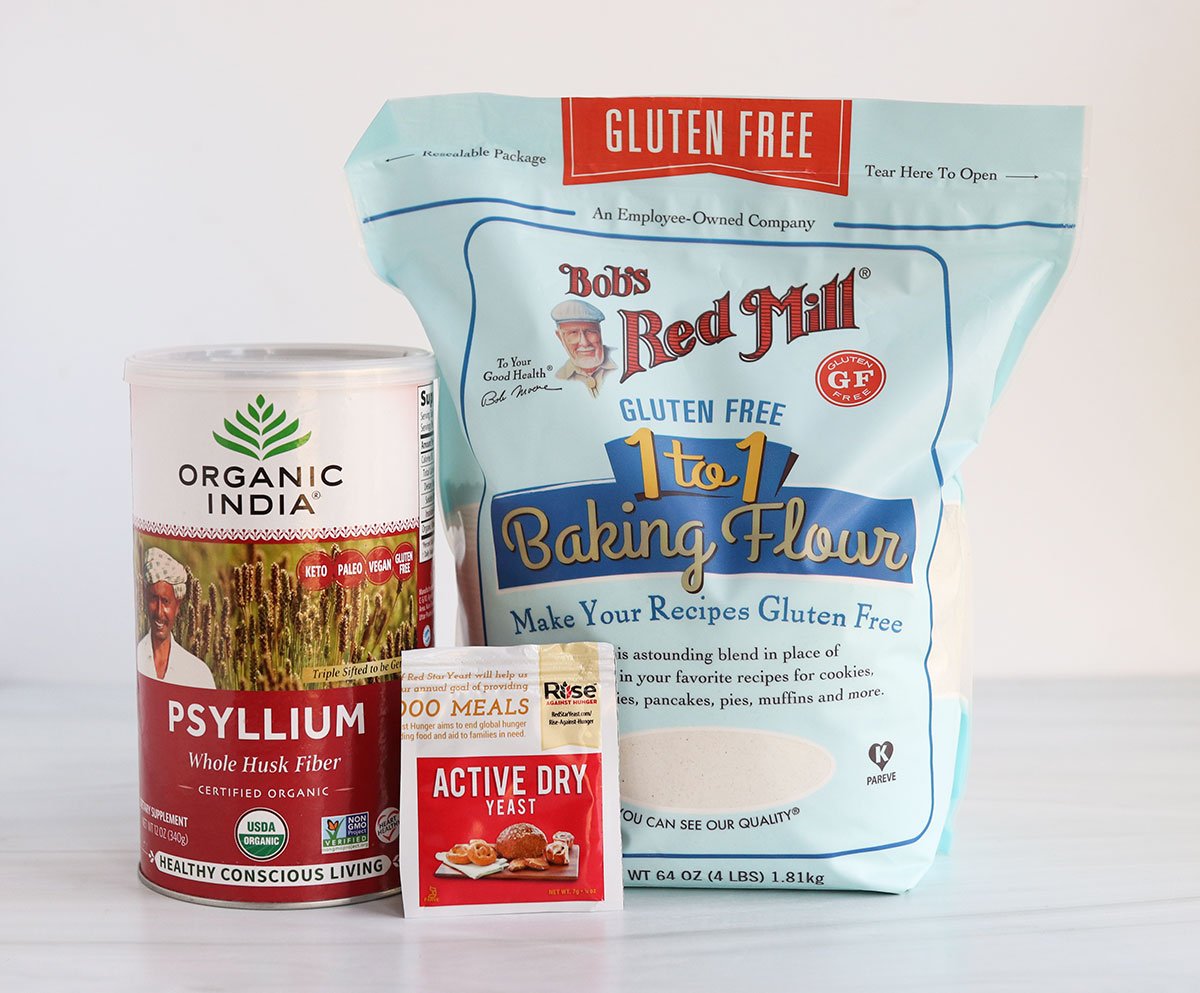
Curious about psyllium husk? This magic ingredient will take your gluten-free baking to the next level. (It’s a common fiber supplement that I stir into water most mornings.)
You can easily find this ingredient at grocery stores in the supplement section, online, or in a health food store. This recipe calls for whole psyllium husks (affiliate link), not psyllium husk powder, so be sure to check your packaging. It should look like ground flax seed, only lighter in color.
How to Make the Best Gluten-Free Cinnamon Rolls
1. Proof the yeast.
In a medium bowl, combine the very warm, but not too hot water (between 105º and 115ºF is ideal), 1 teaspoon of sugar, and 1 (1/4 oz.) packet of yeast. (This is roughly 2 teaspoons, or 7 grams.)
Let the yeast mixture rest for 5 minutes. It should develop a foam on top, which will let you know that the yeast is good.

2. Mix the psyllium gel.
In a small bowl, combine the psyllium husks and 3/4 cup of warm water. Stir the mixture together until it starts to thicken. If you’ve ever made a flax egg before, it will look similar, but thicker after resting.
Set the bowl aside until you’re ready to add it in.
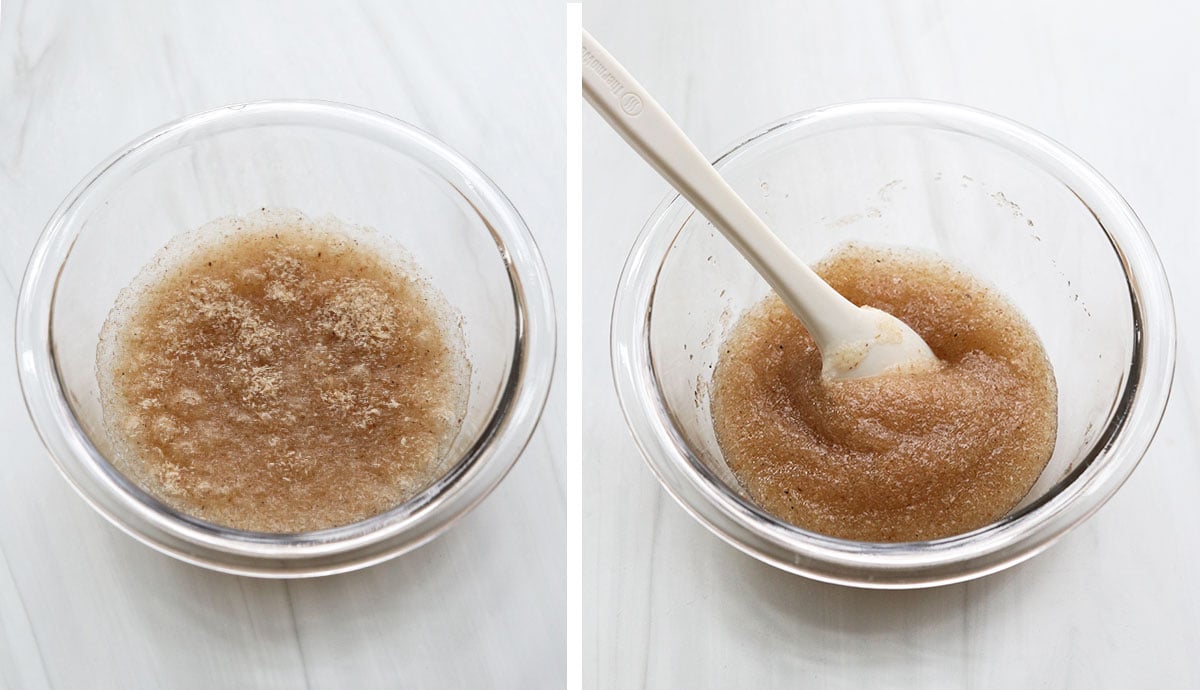
3. Mix the cinnamon roll dough.
In a large mixing bowl, combine the gluten-free flour blend, sugar, baking powder, and salt. Whisk well, to make sure the dry ingredients are well mixed.
Next, add in the egg, melted butter, and the yeast mixture once it has developed the foam on top. Stir well, then add in the psyllium mixture. It will be very thick, but keep stirring until the batter looks uniform.
Gluten-free cinnamon roll dough will be slightly more moist and sticky than you might expect, but the flour will continue to absorb some of the moisture as it rests.
Transfer the bowl of dough to a warm spot to rise for 1 hour. (A “proof” setting in your oven is ideal, but you can also set the bowl on a low-heat heating pad and cover it with a towel or plastic wrap if your kitchen is cold.) The dough won’t double in size, but it should expand.
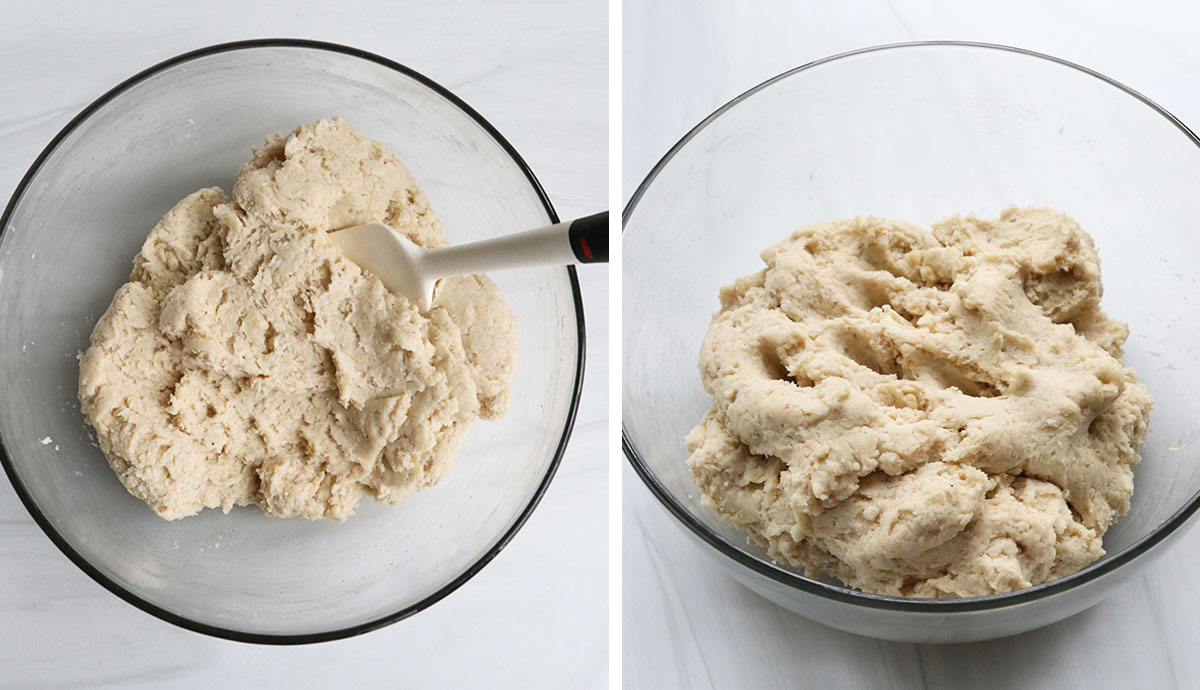
4. Roll the dough.
Once the dough has had the chance to rise, knead the dough to make sure it’s well-mixed directly in the bowl. The underside of the dough will be more moist than the top, so it might stick to your fingers slightly. This is okay!
Transfer the kneaded dough to the center of a large piece of parchment paper on your counter.
Cover the dough with another large piece of parchment paper, then use a rolling pin to roll the dough into a large rectangle, about 11 by 16 inches in size, and 1/8-inch thick. The extra layer of parchment on top will prevent you from needing to add more flour to the recipe.

Remove the top piece of parchment paper, then pour the melted butter on top and spread it around the rectangle. Sprinkle on the brown sugar and a generous layer of cinnamon. Leave a 1/2-inch of dough at the top plain, so it will be easier to seal the roll later.
Starting at the bottom of the rectangle, lift the parchment paper with both hands and roll the dough in on itself. Gluten-free dough is relatively fragile, so using the parchment paper will keep it rolling smoothly. Continue rolling up the dough until you reach the other side.
Use your fingers to pinch the roll closed, then use a sharp knife (or use unflavored dental floss) to slice the rolls. You should get roughly 10 rolls from this recipe.
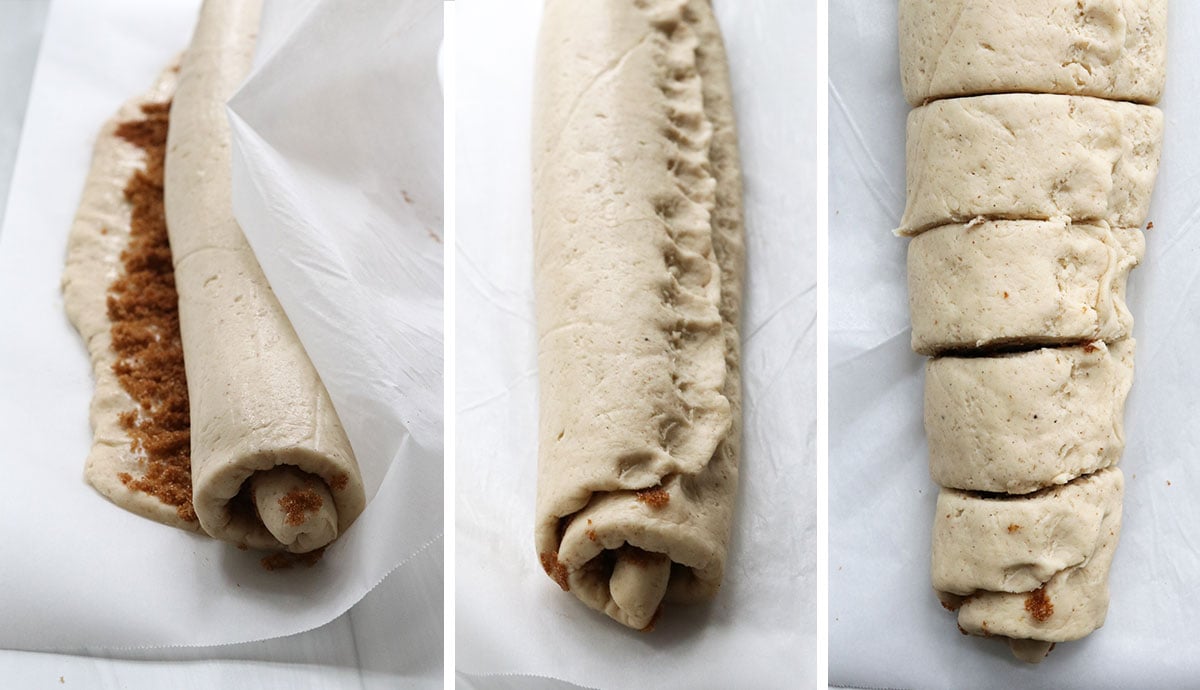
5. Let them rise again.
Grease the bottom of a 9-by-13-inch baking pan and arrange the rolls in the pan. You can also use two 8-inch cake pans instead.
Place the pan back in the same warm spot, to allow the rolls to rise for a second time, about 1 more hour. They should grow in size and start to fill up the pan. When you have 20 minutes left on the second rise, preheat the oven to 350ºF.
Pro Tip: Pour 3 tablespoons of melted butter into the bottom of the baking dish, making sure to grease the sides of the pan, too. Sprinkle roughly 2 to 3 tablespoons of sugar over the butter, then arrange the sliced cinnamon rolls on top. As they bake, the butter and sugar will caramelize on the bottom of the cinnamon rolls, making them extra delicious.
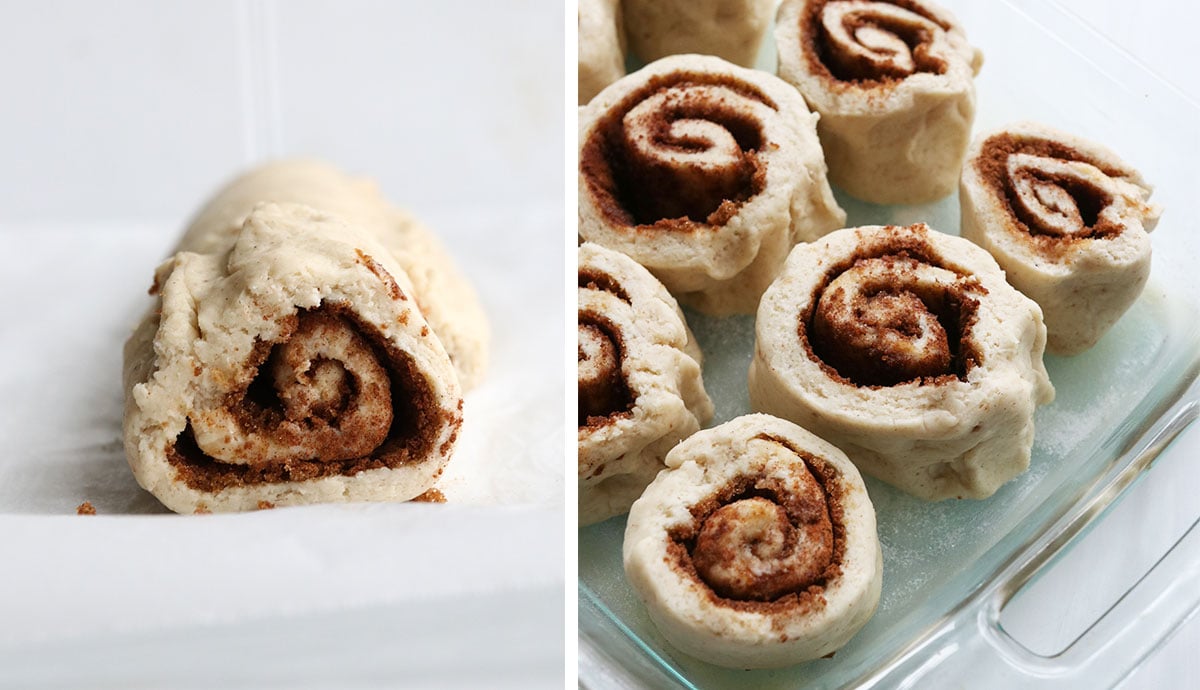
6. Bake.
Once the rolls are done rising, bake them at 350ºF for 25 minutes, until the tops look dry. They won’t become quite as golden brown as normal gluten-containing cinnamon rolls, but they should grow in size and fill the pan as they bake.
Remove the pan from the oven and let the cinnamon buns cool for 10 minutes.

7. Frost.
While the cinnamon rolls cool, stir together the melted butter, powdered sugar, vanilla extract, and water to make a melt-in-your-mouth glaze. Or, use your favorite cream cheese frosting, or try cashew frosting for a naturally sweetened option.
Serve the cinnamon rolls right away after frosting, or let them rest until you’re ready to serve. They are delicious at room temperature, too!
Be sure to transfer them to the fridge and cover them tightly if you don’t serve them within 2 hours, though.
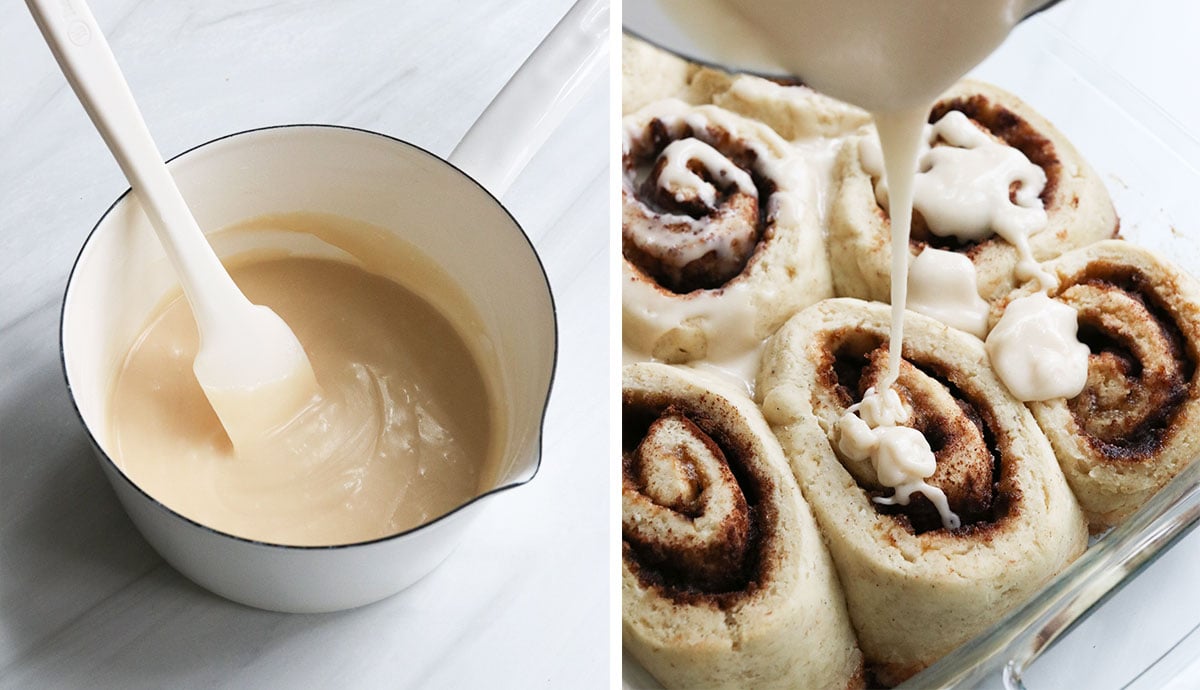
Frequently Asked Questions
If you want cinnamon rolls that are similar to the kind made with all-purpose flour, then yes, the psyllium husk is the magic solution. If you don’t mind a cinnamon roll that has more of a biscuit consistency, you can use an extra egg as a substitute for the psyllium gel. (The egg will replace the 3 tablespoons of psyllium plus the extra 3/4 cup water you would mix it with.)
Yes, of course! Simply use coconut sugar as a swap for the other granulated sugars in this recipe. The resulting rolls will look a little darker than traditional cinnamon rolls in this case, but they will still taste delicious. For a naturally sweetened frosting, try cashew frosting, or simply drizzle them with a little warm maple syrup before serving.
Do not use almond flour or coconut flour in this recipe, as this recipe relies on the starches found in gluten-free blends (like tapioca starch or potato starch). This recipe was developed using Bob’s Red Mill 1-to-1 Baking Flour, so that will give you the most foolproof results, but you can also experiment with using another gluten-free baking blend.
Be sure that the blend you use includes xanthan gum for the best results, and keep in mind that other brands will taste different. (King Arthur’s brand measure-for-measure blend is not as delicious, in my opinion.) If you prefer to use regular GF flour, be sure to add 1/4 teaspoon of xanthan gum for every cup of flour you use.
Yes, you can mix this dough in the bowl of a stand mixer with a paddle attachment, if you prefer. It’s not necessary, though! After the first rise, you should be able to knead the dough with your hands, with just a little bit of the dough sticking to your fingers, and that will give you the same results as using a stand mixer.
You can easily replace the melted butter with vegan butter or melted coconut oil. (Use refined coconut oil for zero coconut flavor.) To replace the egg, use 1 extra tablespoon of psyllium husk plus an extra 1/4 cup of hot water when you mix the gel.
You can prepare this gluten-free cinnamon roll recipe ahead of time by mixing the dough, letting it rise, and then rolling the cinnamon roll into a log. Tightly wrap the log with parchment paper or plastic wrap, and let it chill in the fridge for up to 48 hours.
When you are ready to bake the cinnamon rolls, slice them and arrange them in the pan. The chilled dough will need to rise in a warm spot for 2.5 hours, and then you can bake as directed. (I have not attempted to freeze these, so I can’t comment on how that will work yet.)
Looking for more gluten-free recipes? Try Gluten-free Pretzels, Almond Flour Cookies, Almond Flour Pizza Crust, or my favorite Oat Flour Pie Crust.
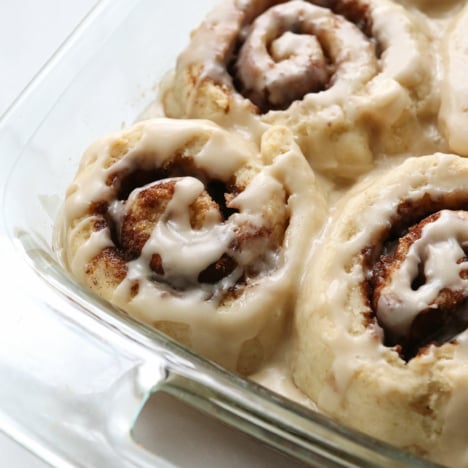
Ingredients
Cinnamon Roll Dough
- 1 cup very warm water
- 1 (¼ oz) packet active dry yeast
- 1 teaspoon sugar
- 3 tablespoons whole psyllium husk (see notes)
- 3 ½ cups Bob's Red Mill 1-to-1 gluten-free baking flour
- ½ cup sugar
- 2 teaspoons baking powder
- ¾ teaspoon fine sea salt
- 1 large egg (at room temperature)
- ½ cup melted butter
Filling
- 2 tablespoons melted butter
- ½ cup brown sugar
- 2 ½ teaspoons ground cinnamon
Caramelized Bottom of the Pan (Optional)
- 3 tablespoons melted butter
- 3 tablespoons sugar
Frosting
- 2 tablespoons melted butter
- 1 ½ cups powdered sugar
- 1 teaspoon vanilla extract
- 2 tablespoons water
Instructions
- Add 1 cup of very warm water to a medium bowl, and sprinkle in the 1 teaspoon of sugar, and the packet of yeast. Set it aside to proof, about 5 minutes. A foam should develop on top, which will let you know that the yeast is good. (If no foam develops on top after 5 to 10 minutes, you might want to try a different batch.)
- In another separate bowl, combine the 3 tablespoons of psyllium husk with an additional ¾ cup of very hot water. Stir well, and set it aside. (The husk will thicken up significantly, forming a thick gel.)
- In a large mixing bowl, combine the gluten-free flour, sugar, baking powder, and salt. Whisk well to mix the dry ingredients, then add in the egg, melted butter, and the yeast mixture, after the foam has developed on top. Add in the psyllium husk gel, and mix well, until the dough looks thick and relatively uniform.
- Place the bowl of dough in a warm place (like in an oven on a "proof" setting, or on a low-heat heating pad) to rise for 1 hour. The dough will not double in size, but it should expand.
- When the dough is finished rising, knead it in the bowl for 2 minutes. The underside of the dough will feel slightly sticky, so don't be surprised if it sticks to your fingers a bit. (Don't add more flour, though. You should be able to wipe the dough off the tips of your fingers and drop it back into the bowl.)
- Place a large piece of parchment paper on the counter, and set the dough in the center. Cover the dough with another large piece of parchment paper, so it won't stick to your rolling pin, then roll it out into a large rectangle, about 11 by 16 inches in size. (Roughly ⅛-inch thick.)
- Add the filling to the rectangle, leaving about a ½-inch at the top untouched, so it will be easy to seal the roll later. Spread on the melted butter first, then sprinkle the brown sugar and cinnamon evenly over that. Use the parchment paper under the dough to help roll it up into a long log, starting with the bottom (longest side) of the rectangle and moving your way up to the top. The parchment paper will prevent the dough from breaking as you roll. Once you reach the top, pinch the roll closed at the seam. Cut the log into 10 equal pieces.
- Prepare a 9-inch by 13-inch baking dish by spraying it with oil. Optional: Create a caramelized bottom by spreading 3 tablespoons of melted butter into the bottom of the pan. Sprinkle 3 tablespoons of sugar over the butter, then arrange the cinnamon rolls on top of the sugar, in a single layer in the pan. The butter and sugar on the bottom will caramelize as the cinnamon rolls bake, creating a delicious bottom side to the rolls. Place the pan back in a warm spot to rise for 1 more hour. The cinnamon rolls should grow in size, but not necessarily double.
- Preheat the oven to 350ºF for at least 20 minutes in advance, so the oven comes to the proper temperature. When the cinnamon rolls are done with the second rise, place them in the preheated oven to bake for 25 minutes. Gluten-free rolls don't brown the same way gluten flour does, so they won't be golden brown, but they should feel dry to the touch and spread to fill the pan. Remove them from the oven and let them cool for at least 10 minutes while you mix the frosting together.
- To prepare the frosting, combine the melted butter, powdered sugar, vanilla, and water. Stir well, until the frosting looks smooth. You can add an additional teaspoon of water, if needed, to thin out the texture. Spread the frosting over the warm cinnamon rolls, then they are ready to serve. Leftovers can be stored in an airtight container in the fridge for up to 5 days.
Notes
Nutrition
If you try this gluten-free cinnamon roll recipe, please leave a comment and star rating below letting me know how you like them.
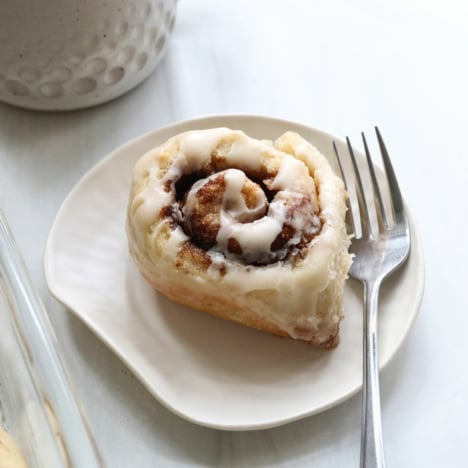
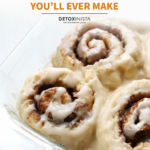











“This is the best cinnamon role ever!” Says my step-daughter who isn’t GF. These were Incredible! I mean, wow! The psyllium husk was a bit tricky to find, but it was well worth all the effort.
Disaster dough! To start, this was a sticky mess that wouldn’t come off the parchment. I followed to a T, buying K.A. flour and all. Secondly, and more concerning is the psyllium husks- DO NOT USE IF YOU HAVE AN INFLAMMATORY BOWEL DISORDER! This will trigger the worst diarrhea. It was so bad I called my GI Dr and after reviewing ingredients, he confirmed no psyllium husk consumption for IBD. It also turned the dough brown, like a whole wheat brown. So I’m not sure how these pictures look so white, which ended the moment the psyllium gel was added… and then death to my intestines.
Oh, darn, it’s always disheartening to hear that a recipe didn’t work for someone after all of that testing! I did not have a chance to test with King Arthur flour yet (did you use the measure for measure variety?), but I will most likely try that next. And I’m sorry to hear that the psyllium husk didn’t agree with you. I’ve only been able to find positive research regarding psyllium husk and IBD, so that’s frustrating to hear. I hope you find a recipe you enjoy better next time.
Most research is on fiber in realation to IBD’s, which can include a form of psyllium. The caveat is that the wrong form (like the husk that has larger particles) and the wrong dose of psyllium can actually trigger diarrhea. This has also been noted in research.
I can not used psyllium husks. Wondering if konjac could be used?
I’m afraid I’ve never worked with that ingredient before, so I couldn’t tell you how that might work. Please let me know if you experiment with it!
These were superb! Really wonderful, soft, fluffy and delicious! Will definitely make these again and again. We made them ahead and then put them in the fridge cut and ready for the second rise which we did for 2+ hours. Worked perfectly. Thanks Megan!
I’m glad you enjoyed them, Lisa. Thanks for taking the time to leave a review!
Confirmed – the best! NonGF guys in my family had seconds. I prepped two days ahead (refrigerated as the log). Also used coconut sugar. Christmas morning I let them rise in a warm spot straight out of the refrigerator for an hour, but then was about another two hours before I got where I was going and put them in the oven. Only down side was they stuck to the parchment after refrigerating and I probably should have done the warm rise for longer than I did but ran out of time. They turned out pretty perfect though. My family was surprised I actually made this dough myself! Haha
Yay! I’m glad you agree! And that’s awesome that you could make them two days in advance– thanks for sharing the tips on rising after that.
Wow! Your recipes always amaze me. Thank you so much! These were fabulous and my family couldn’t believe they were gluten free. I made them as written the night before, refrigerated the log. In the morning I sliced them and let them do the second rise in the oven on proof mode. A little more than 2 hours. Delicious!
I didn’t have powdered sugar so I made up a cream cheese, Greek yogurt, maple syrup and vanilla mix. It did the trick!! Thank you!!
I’m so glad you were able to make these ahead of time! Thanks for sharing what worked, and your frosting sounds delicious, too!
This recipe is amazing!!! I’ve made some pretty terrible/crumbly gf cinnamon rolls but these are game changer!! I only had ground psyllium husk powder and didn’t notice until I was almost done making the dough but regardless they’re still tasty. I’m super impressed with the recipe and the process was honestly fun! Thanks for creating this!!
Yay! I’m glad you enjoyed them, Evelyn! I think they are fun to make, too. Thanks for taking the time to leave a review!
My family looks at me crazy when I ask them to try my gluten free recipes. They actually loved these cinnamon rolls!! Thank you for sharing.
I love it when that happens! I’m so glad to hear that everyone loved them. Thanks for the review, Denise.
Wow! I haven’t been able to have a decent cinnamon roll on Christmas morning in years!!! Thank you so much!!!
Glad you enjoyed them, Christina!
I made these yesterday and substituted extra psyllium husk+water for the egg and used vegan butter. They were delicious! Reminded me of the gluten, butter filled cinnamon rolls my mom used to make. Will definitely be making these again!
Perfect! I’m glad the egg substitute worked for you, too! Thanks for the review, Andrea.
Absolutely AMAZING!
Perfect texture, perfect sweetness, and doesn’t make you feel sluggish after eating. This will be my go-to cinnamon roll from now on.
I’m so happy to read this, Whitney. Thank you for the review, and I’m glad they were a hit!